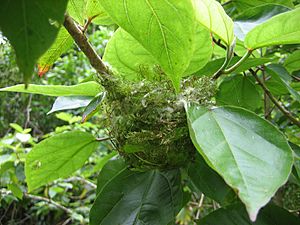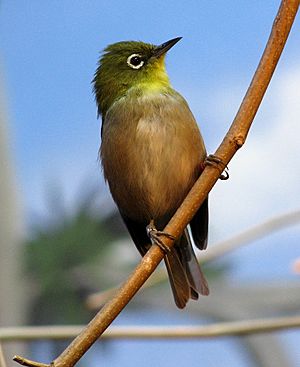Japanese white-eye in Hawaii facts for kids
The Japanese white-eye (Zosterops japonicus) is a small bird that originally comes from East Asia, including countries like Japan, China, and the Philippines. However, in Hawaii, it has become an invasive species. This means it's a type of animal that was brought to a new place and now causes harm to the local environment.
The Japanese white-eye was first brought to Hawaii in 1929. People hoped it would help control insects. But since then, it has become very common across the Hawaiian islands. It now causes problems for Hawaii's native birds, like the Hawaiian honeycreeper, by spreading diseases. It also helps spread seeds of unwanted plants.
Contents
How the Japanese White-eye Harms Native Hawaiian Birds
The Japanese white-eye has been very successful in Hawaii partly because native Hawaiian birds weren't ready for it. When species live together for a long time, they often coevolve. This means they change and adapt to each other. But the white-eye and Hawaiian birds didn't coevolve.
Because of this, the white-eye has some advantages. For example, it can resist diseases like avian malaria, which native Hawaiian birds cannot. This means the white-eye can survive better, while native birds get sick more easily.
Competition for Food and Space
The Japanese white-eye has spread quickly across the Hawaiian Islands. This rapid spread is a big problem for native birds. Many native Hawaiian birds, like the Hawaiian honeycreeper, have very specific diets. Honeycreepers, for example, mainly eat nectar from flowers.
The white-eye, however, can eat many different things, including nectar, fruits, and insects. This means it can find food in many different places. Because the white-eye can eat so many things, it competes directly with native birds for food. This competition has caused a big drop in the number of honeycreepers. It's like two people trying to eat from the same small plate of food – the one who can eat more kinds of food will do better.
Studies have shown that as the number of Japanese white-eyes increased, native birds started to struggle. Their young birds were smaller and had shorter beaks. These changes made it harder for them to find food and survive. Birds whose beaks were similar to the white-eye's suffered the most. For instance, the Hawaiian akepa, an endangered bird, struggled much more after 2000, when white-eye numbers went up.
The white-eye also competes for space. It has moved into many areas where native birds used to live. When the white-eye becomes more common in an area, native birds become less common. Many Hawaiian birds are already endangered or have even disappeared. This is believed to be linked to the white-eye's invasion.
Effects on Hawaiian Plants

Many native Hawaiian birds that have disappeared used to help pollinate plants. Pollination is how plants reproduce, often by birds or insects moving pollen from one flower to another. Now, there's a worry about certain plant species, like the Hawaiian Lobelioideae, because their natural pollinators are gone.
Some people wonder if the Japanese white-eye could help pollinate these plants instead. The white-eye does visit flowers and could move pollen. However, we need more studies to know if they are good at it. If they do pollinate, it might change how plants mix their genes, which is called outcrossing. Outcrossing can be good because it increases genetic diversity, making plants stronger against diseases. But more research is needed to understand the full effects.
Seed Dispersal by White-eyes
A similar situation happened when the Japanese white-eye was introduced to the Bonin Islands in Japan. Even though the bird is from Japan, it wasn't originally on these specific islands. There, the white-eye started to take over the job of spreading seeds, which native birds used to do.
However, in Hawaii, the white-eye doesn't usually spread seeds. This is because they rarely eat the seeds of Hawaiian plants, like the firetree. Because they don't eat the seeds, they can't carry them far away.
Islands are very special places. They are often more vulnerable to new animals, predators, or diseases that are introduced. This is because the plants and animals on islands have evolved without these new threats. The actions of the white-eye, whether it's spreading disease or changing pollination, show how much impact an invasive species can have.
Images for kids




